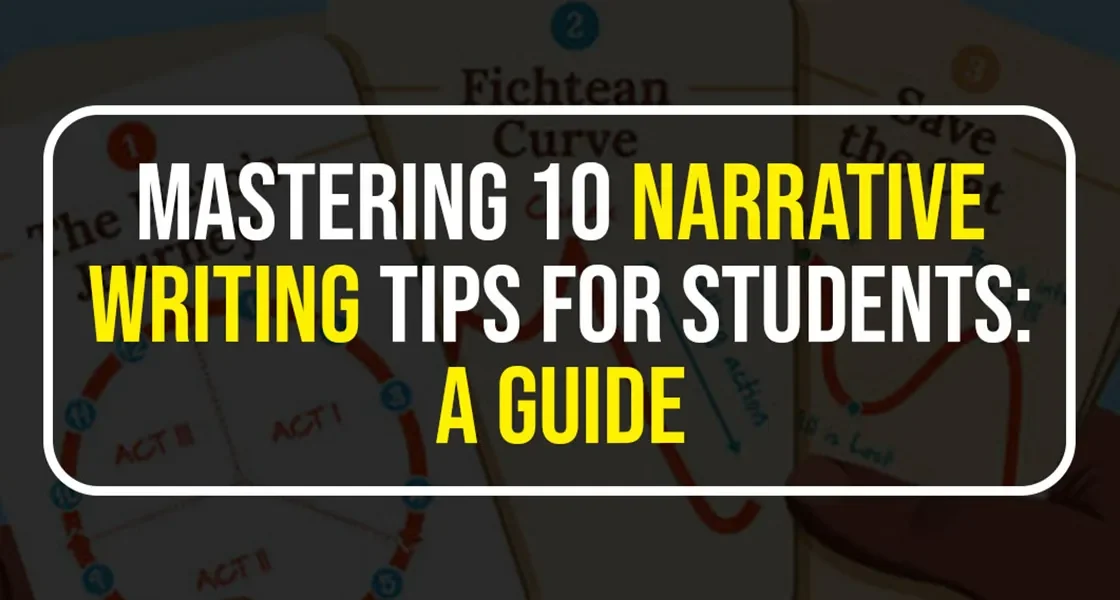
Table of Contents
ToggleBoost Your Creativity to Unlock 10 Narrative Writing Tips For Students.
Are you struggling to weave captivating narratives? Don’t worry! Narrative writing is a fascinating art that lets your creativity soar and takes readers on unforgettable adventures.
But wait, there’s more. It’s not just about improving your writing skills; narrative writing also cultivates empathy, critical thinking, and emotional intelligence, making you a well-rounded communicator.
In this blog, we’re diving deep to reveal essential narrative writing tips designed especially for students like you. Get ready to learn how to bring characters to life, transport minds with vivid settings, and keep readers on the edge of their seats with thrilling tension.
Are you excited yet? Join us on this magical writing journey as we explore the secrets to becoming a masterful storyteller who crafts engaging and impactful tales that leave a lasting mark. Let’s embark on this adventure together.
How to Craft Compelling Narrative: Tips, Example & Step By Step Guide for Great Writing

Want to write captivating stories? Our step-by-step guide has tips, examples, and practical advice for great writing. Unleash your storytelling magic! Learn, create, captivate. Master the art of compelling narratives with our guide. Be creative, mesmerize your readers, and leave a lasting mark. Join the exciting journey to become a storytelling wizard.
1 Choose an Intriguing Topic:
The foundation of a great narrative is a captivating topic. Encourage students to select a subject close to their hearts, or that sparks their curiosity. Personal experiences, dreams, or fictional adventures can be excellent starting points.
Example: Write a story about a young explorer who embarks on a journey to find a legendary lost city in the jungle.
-Consider your interests and experiences to find a topic that excites you. Brainstorm different ideas and choose one that you can connect with emotionally.
2 Develop Strong Characters:
Characters breathe life into stories. Students should focus on developing well-rounded characters with distinct personalities, motivations, and flaws. Readers connect more deeply with relatable and multidimensional protagonists.
Example: Create a character named Alex, who is an introverted bookworm but discovers their bravery when faced with unexpected challenges.
-Write character profiles detailing their background, personality traits, and motivations. Consider how their past experiences shape who they are in the present.
3 Set the Scene with Vivid Descriptions:
Transport your readers to the story’s setting through descriptive language. Engage all the senses to create a vivid atmosphere that immerses the audience in the narrative.
Example: Describe a moonlit forest with towering ancient trees, their gnarled branches creating eerie shadows on the forest floor, and the gentle leaves rustling in the night breeze.
– Practice describing different environments using all the
senses; sight, sound, smell, touch, and even taste – to make the scenes come alive.
4 Structure with a Compelling Plot:
A compelling plot keeps readers hooked from the beginning until the end. Encourage students to outline the story’s beginning, middle, and future with a clear conflict and resolution.
Example: Begin with the protagonist finding a mysterious map, then encountering obstacles and allies during their journey, leading to a dramatic showdown with the antagonist at the lost city.
– Create a story outline or a storyboard to map out your narrative’s key events and turning points. Ensure a clear progression from the story’s beginning to the resolution.
5 Show, Don't Tell:
One of the golden rules of narrative writing is to “show, don’t tell.” Instead of directly stating emotions or events, let the readers experience the story through actions, dialogue, and sensory details.
Example: Instead of stating, “Sarah was afraid,” show how she trembled and her heart raced when she heard the strange noises in the dark.
-Rewrite scenes using descriptive language, action, and dialogue to convey emotions and events without explicitly stating them. Use sensory details to engage readers.
6 Build Tension and Suspense:
A well-crafted narrative thrives on tension and suspense. Introduce obstacles, challenges, or mysteries that keep the readers eager to discover what happens next.
Example: Introduce a mysterious figure following the protagonist, leaving cryptic clues behind, and raise questions about their true intentions.
– Experiment with creating cliffhangers and moments of uncertainty to keep readers intrigued. Balance tension with moments of relief to maintain a dynamic narrative.
7 Master Dialogue:
Dialogue is a powerful tool for character development and advancing the plot. Encourage students to write natural and engaging conversations that reveal personalities and motivations.
Example: A conversation between two friends who argue about whether to continue their quest or turn back.
– Read your dialogue aloud to check for authenticity and natural flow. Use dialogue tags and actions to enhance the characterization and emotions behind the conversation.
8 Utilize Figurative Language:
Figurative language, such as similes, metaphors, and personification, adds depth and richness to narratives. Please encourage students to sprinkle these literary devices throughout their writing.
Example: The river flowed like a shimmering ribbon through the lush green valley while the stars danced in the night sky like diamonds.
-Practice incorporating similes, metaphors, and other figurative language in your writing. Use them judiciously to enhance descriptions and evoke imagery.
9 Edit and Revise:
Remind students that writing is rewriting. Please encourage them to revise their work multiple times, focusing on clarity, coherence, and grammar. Peer reviews can also be beneficial during this process.
Example: After completing the first draft, go back to clarify confusing passages, improve sentence structures, and correct grammatical errors.
-Develop a revision checklist to address aspects like plot consistency, character development, and sentence variety. Seek Feedback from peers or teachers to gain fresh perspectives.
10 Embrace Feedback:
Positive Feedback reinforces good writing habits, while constructive criticism helps students grow as writers. Encourage a supportive writing community where students can exchange ideas and provide Feedback to one another.
Example: Share your story with fellow writers, and receive praise for your engaging plot and well-developed characters, along with constructive Feedback to improve dialogue.
-Be open to Feedback, both positive and critical. Use it as a tool to grow as a writer and refine your narrative skills. Remember that constructive criticism is valuable for improvement.
Conclusion:
Narrative writing empowers students to unleash their creativity and share meaningful stories with the world. Students can craft compelling narratives that captivate readers by choosing intriguing topics, creating strong characters, and employing vivid descriptions. As they embrace feedback and edit their work diligently, students will refine their skills and become confident storytellers.
FAQs
Narrative writing aims to tell a story, entertain, and evoke emotions in readers. It allows writers to explore their creativity while developing their writing skills.
Inspiration can come from various sources, such as personal experiences, dreams, books, movies, or even news articles. Keep an open mind and observe the world around you.
Using real people as characters can be tricky, as it may raise ethical concerns. If you choose to do so, ensure you portray them respectfully and with their consent.
To improve dialogue writing, listen to real conversations to grasp natural speech patterns. Focus on character voices and intentions, ensuring each line contributes to the plot or character development.
The ideal length varies depending on the story’s complexity and target audience. A shorter length of 1,000 to 1,500 words is usually appropriate for student narratives.
Yes, mixing genres can add an exciting twist to your narrative. However, ensure the blend is coherent and enhances the overall storytelling experience.
To overcome writer’s block, take breaks, change your writing environment, and engage in activities that spark creativity, like reading or brainstorming.
The choice between first-person and third-person narrative depends on the story’s perspective and the intimacy you want to create with the reader.
Absolutely! Humor can make narratives more engaging and enjoyable. However, ensure it aligns with your story’s overall tone and theme.
Focus on originality, emotional depth, and a unique perspective to make your narrative stand out. Experiment with unconventional storytelling techniques and themes.